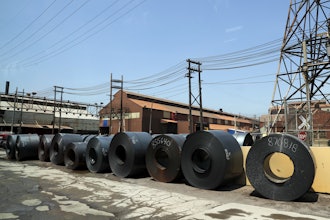Big data is not just for predicting election outcomes and mapping genomes. General Electric (GE) is betting on the so-called Industrial Internet — a term they coined — to help manufacturers boost performance, streamline processes and better compete in the global marketplace.
Essentially, the Industrial Internet (II) is a network that connects scores of sophisticated machines embedded with sensors and computer software to other machines so manufacturers can gain real-time insight into everything from production bottlenecks to pending maintenance issues. The result is a transparent system that enables businesses to make more informed business decisions, curb production hiccups and cut costs.
“Ethernet-enabled devices are so widespread now that everything is connected to everything else,” says Jim Pinto, author of “How to Win in the Automation Business” and a consultant specializing in industrial automation. “Machines are now capable of talking to each other.”
The potential benefits of the II are massive. A recent GE report reveals that II applications could add $15 trillion to the global GDP by 2030 through productivity improvements. By combining remote sensors, radio-frequency identification (RFID) technology and sophisticated software with wireless networks, the II can extract data from connected machines to enable real-time resolution of manufacturing change orders, quickly detect production bottlenecks and estimate time-to-complete production cycles with increased accuracy, among other productivity-boosting activities.
With capabilities like these, a billboard manufacturer can suddenly determine where they’re running short on certain sub-components, at what speed steel I-beams are being mounted on poles and if electrical wiring processes are about to fall out of accordance with electrical codes.
Automation has long helped manufacturers streamline processes, but the increasing popularity of cloud computing and declining instrumentation costs are rapidly ushering in the II era. Here are five ways in which manufacturers can take advantage of this high-tech industrial revolution.
1. Gain efficiency.
GE is putting its money where its mouth is with the recent opening of a $170-million advanced battery manufacturing plant in Schenectady, NY. The 180,000-square-foot facility produces GE’s next-generation Durathon batteries, which are half the size of traditional batteries but last ten times as long.
What makes the plant truly remarkable is that its sophisticated machines have been outfitted with 10,000 sensors that are connected to a high-speed internal Ethernet, according to an article in MIT Technology Review. The facility relies on these sensors to track details such as local air pressure, energy consumption, temperature range and which batches of powder are being used to produce which batteries.
By enabling the plant’s 450 employees to access this real-time data via an iPad and Wi-Fi connectivity, GE can make huge efficiency gains, pushing their machines to their technical limits while being able to anticipate potential production snags.
Continental Tires is another manufacturer that has turned to the II to boost efficiency. The tire division of Continental AG deployed a Cisco Unified Wireless Network designed to track and manage tire assembly and material carriers across the entire manufacturing floor.
The solution enables fork truck operators to quickly find and deliver materials and tire components to the correct work station in accordance with customer orders and tight manufacturing schedules. By installing mobile computers and Wi-Fi tags on each forklift and connecting these to a wireless network, Continental Tires is able to help operators locate and coordinate the movement of parts and materials more efficiently, thereby cutting work-in-progress scraps by 20 percent and improving production efficiency thanks to tracking capabilities.
2. Reduce waste.
To make the most of power consumption at its multiple plants, Canadian paper company Cascades turned to OSISoft, whose software captures and analyzes data relating to manufacturing processes. Using this software, Cascades built an Energy Monitoring and Information System (EMIS) that helps their mills reduce energy consumption by limiting overuse.
The system monitors the energy performance of the mills in real-time using a combination of Ethernet network connections and an OSISoft server. By implementing this technology, Cascades saw a return on its investment in II equipment in less than two years through reduced energy waste.
Technology can help manufacturers decrease waste in numerous ways, according to Mark Davidson, a principal analyst with LNS Research, an industrial automation advisory firm. “Resulting reductions in waste can come from areas such as reduced materials, reduced energy and resource usage, improved quality, reduced scrap and rework, and reductions in manual labor,” he says.
3. Enhance machine productivity.
Given the steep competition within the automobile industry, an increasing number of manufacturers are embracing II technology as a way to optimize shop floor performance. One such manufacturer is Audi. The German auto manufacturer selected Forcam’s Factory Framework software to better manage its car component production. The solution works by extracting web-based performance data from machines and plants in real-time to minimize errors and waste during production.
Each machine’s output is carefully measured so that productivity killers like downtime can be immediately flagged, enabling Audi to better plan around these production disruptions in order to optimize the use of its plants and improve target planning. The results have been significant — Audi has realized a 20 percent boost in productivity since introducing Forcam’s Factory Framework software.
BorgWarner Cooling Systems, which builds engine radiator systems for commercial vehicles, is is another manufacturer that has improved its machine productivity using Forcam’s technology. The company deployed a custom-fit production management system for 40 machines that collects and processes machine and operating data. Operators at the shop floor level are able to view dashboards illustrating downtime information, points of failure along the assembly line, unexpected production disruptions and deviations from production targets.
“Manufacturers are always striving for ways to continuously improve their productivity and cut costs,” says Mohamed AbuAli, COO of Forcam. “With the right tool that can deliver the right information to the right people at the right time, manufacturing facilities can use objectively-measured data directly from their shop floors to complement their Continuous Improvement Process (CIP) and gain significant productivity gains.”
4. Identify maintenance issues before they occur.
One of the most common causes of machine breakdown is excessive wear and tear on a machine’s belt. With II technology, built-in sensors can monitor a machine’s usage patterns and output to alert a plant manager when a belt is about to reach its maximum threshold for usage and requires immediate maintenance.
The potential financial rewards are enormous. According to a November 2012 report by GE, a one percent gain in fuel efficiency and reduced unscheduled maintenance would result in savings of $30 billion within the aviation industry over the next 15 years.
The airline industry isn’t the only benefactor of technology capable of flagging malfunctions before they occur. Pinto points to Procter & Gamble as a hypothetical example of a manufacturer whose $83.68 billion dollars in 2012 sales would be significantly impacted if its diaper manufacturing plants began to experience glitches. “With these types of companies, if something jams, everything stops,” he warns.
Fortunately, today’s ecosystem of machines, people and data promises to change all that. “Maintenance up until now has been after the fact,” says Pinto. “However, II maintenance is really about predictive maintenance so that the Internet automatically tells you when a machine is about to fail.”
5. Cut costs in a tough economy.
Regardless if it’s a scheduled maintenance period or an unanticipated malfunction on the assembly line, plant downtime can cost a manufacturer hundreds of thousands of dollars, if not more. Attaching a dollar figure to this nightmare is difficult, but factors include labor costs, energy surges, inspection fees, wasted manufacturing space and production bottlenecks.
With II technology, however, these issues would occur far less frequently. Linking machines to sophisticated, data-gathering software can help identify a machine that’s not performing at peak levels and is in need of maintenance before a breakdown occurs. Increased productivity can also ensure manufacturers spend more time producing products and parts than tending to low-value maintenance tasks.
“As manufacturers use the Industrial Internet to create faster visibility of business and manufacturing information, their employee teams can work more productively and efficiently with aligned business and manufacturing goals,” says Davidson. “This can be a great source of cost savings.”
Whether it’s improving efficiencies or flagging machine malfunctions, the II promises to revolutionize the way manufacturers use big data. In the end, however, these companies must be willing to transform their key processes in order to embrace these new technologies and reap the benefits they can yield.
This article was written by Software Advice contributor Cindy Waxer, and first appeared on their blog as "5 Ways Manufacturers Can Take Advantage of the Industrial Internet."


















